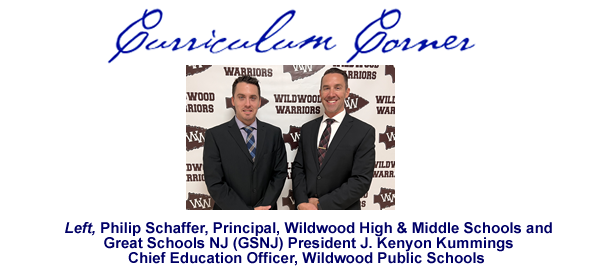- NJASA
- Curriculum Corner Oct Nov 2022
-
The Lens of the Whole Child
Wildwood Public Schools is a district that is committed to viewing its student body through the lens of the whole child. That said, the challenges that were compounded by events beginning in the Spring of 2020 required an increased emphasis on the social and emotional learning (SEL) and health of our student body. In response to this need, Philip Schaffer, the principal of our middle and high schools proposed the creation of a Student Advisory Program as an additional safety net and mechanism for addressing the SEL of our students, and to create resources for them to utilize in the process.
The need for student advisory programs is well documented in the research specifically as it relates to how they can facilitate stronger relationships between students and teachers. The social and emotional needs of students are difficult to identify and address within the traditional structure of schools, so advisory programs create the space and opportunity to identify and address such needs. Improved outcomes in academics, discipline, and attendance rates can be directly linked to school connectedness and strong teacher-student relationships.
Both schools involved in the advisory program are housed within the same building and share a principal, which eased the implementation for grades six through twelve. The total enrollment averages around 440 students, educated by approximately 51 faculty members. The structure of the program consists of teacher leaders assigned to advisory teams within the school, where planning, goal setting, and reflection occur. Each grade level has a sequence of themes focused on wellness and life skill topics during advisory time throughout the school year. For example, topics include healthy/unhealthy relationships, self advocacy, and anger/stress relief. Each topic has a sample lesson plan that the advisors can utilize and/or modify when meeting with their groups. The schools schedule an early dismissal once per marking period to give the faculty time to meet and prepare for their advisory meetings with students. Advisory meetings occur once per month and occur by rotating class periods for 45 minutes, so as to evenly distribute across all disciplines.
In talking with the faculty, the consensus is that the advisory program is an effective and necessary component within the schools. Also, the sentiment is that the program has thrived because the implementation was thoughtful and rooted in organizational change theory. For example, the schedule for the year included common planning time with advisory teams to share needs and successes. Limited or no planning time was a deficiency highlighted by the literature attributed to failed implementations of similar programs. The planning process began with meetings to create shared expectations for the program which was followed by a needs assessment, appropriate training, and time for group and individual reflection.
The students have also shared positive responses to the program such as, “We never have time to just talk about life since things are always so busy” and, “It feels good to know that I’m not alone with some of the stuff I am having trouble with. This feels like a family”. The program is now in its second year, and we continue to be proud of its impact and how it is evolving.



